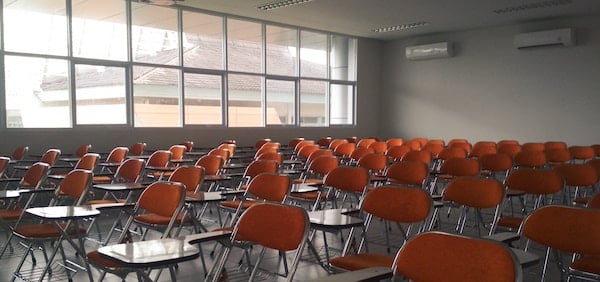Published on
Preparing a Traditional University for the 60-Year Curriculum

The relationship between higher education and the needs of industry training has been growing closer for some time, but especially in this strong economy. Amazon’s recent announcement of plans to re-train a third of its workforce is a significant marker of which higher education institutions should take note. Continuous learning offerings will be a critical element of institutions of all types, not just the ones with current workforce development arms. The Amazon announcement, and those like it, point to a number of societal issues that require the attention of higher education. Among a number of other factors, this shift is brought on by a growing complexity of skills in the information age and a changing demographic.
First, there is an increasing complexity in the information age. Of today’s jobs, 47% will not exist in a decade according to the 2017 Future of Work report from Deloitte. As one might guess, automation and robotics will drive much of this change, but this also opens up opportunities for new skill development around data, artificial intelligence and a number of other technological advancements. Thus, this development of new skills and knowledge will lead to a more generalized workforce rather than a specialized one. Deloitte also notes that 70-90% of future work will be in hybrid or “superjobs” which combine tasks historically performed by someone in one role (Useem, 2019). This move away from specialization will require institutions to carefully consider the way they arrange curriculum—from siloed disciplines to more integrated ones, to a mixture of academic credit and professional credit offerings.
Additionally, a recent report on “Automation and Artificial Intelligence” by The Brookings Institution suggests that 36 million American workers have high exposure to automation and at least 70% of tasks could be automated (Muro, Maxim, and Whiton, 2019). This combination of skill complexity and consequences of automation increases the opportunities for higher education institutions to invest in local workforce needs. Thus, it requires to stay keenly aware of these shifts in the local economy through development of relationships, advisory boards and datasets from EMSI, BurningGlass, Bureau of Labor Statistics and the like.
Finally, demographics will impact the need for continual learning. For the first time in U.S. history there will be as many senior citizens (age 65 or older) as there will be children in 2030, according to The Census Bureau (“Older People Projected to Outnumber Children for First Time in U.S. History”). This change is part of what one group of researchers tackled in their recent book, The 100-Year Life. The authors note that a child born in 1914 had a 1% probability of living to 100 years old. A child born today has a 50% chance of living to be 100 (Gratton and Scott, 2016). This demographic shift and the continuing complexity of society will require rethinking education as more of a continuous endeavor.
Regionally, the Southeast has witnessed a drastic shift in the economic landscape in the last decade. While it has impacted many of our two-year technical and community colleges, the increasing pressures of the aforementioned factors are starting to impact several of the four-year universities in the region and no doubt, across the nation. While some four-year institutions have continuing and professional education arms, many of them are modernizing or moving closer to the center of an institution’s mission. This modernization or addition of continuous learning arms is especially key at historically liberal arts colleges and universities, which can offer a unique perspective related to the hybridized jobs discussed earlier, as well as lay a groundwork for how to learn in order to prepare employees for the need to continually re-tool or upskill.
The concept of the 60-Year Curriculum has been touted as a framework for higher education institutions to face these challenges and is a model for institutions to consider. First developed and espoused by researchers and practitioners at the University of California-Irvine Division of Career Pathways, Harvard Extension School and University of Washington’s Continuum College, the curriculum is meant to be complementary with two, four or six-year degrees. However, it recognizes that these degree timelines are not the end.
Anderson University is a private non-profit and traditional residential campus, but we have been restructuring over the past two years to embrace this paradigm shift of the 60-Year Curriculum in the development of our Online and Continuous Learning (OCL) unit. We are working to equip faculty and students alike to have a mindset for a 60-Year Curriculum, from having them create offerings with alternative credentialing or new modes of delivery, to having learning communities around books like The 100 Year Life and related research.
Through the concept of the 60-Year Curriculum, we have framed our office as not just an extension but as an enhancement to our on-campus programing. Beyond traditional academic programming, new offerings range from K-12 summer camps and connects students from the Anderson University experience to professional development opportunities in education, business and healthcare that allow us to connect industry to our campus experts. Pre-college programs help students recognize that learning can begin at a university prior to freshman year and in the first year of traditional experiences, we must lay the groundwork that it continues beyond a senior year. Further, our increasing engagement with industries and workforce development partners not only strengthens our formal degree programs, but also creates opportunities for our office to connect employers to non-credit offerings or even create customized training programs.
A 60-Year Curriculum involves preparing even first-year students on our college campuses for a lifetime of retooling. As such, professional development initiatives will become more closely tied with traditional curricular expectations and more curricula will see the impact of workforce needs embedded. Drastic reorganization is already happening at some institutions to move the professional development wing to the center of the institution, including the recent merger of UC Irvine’s Career Center with its Continuing Education unit the Division of Career Pathways. We are seeing similar investments at our institution in its recent initiative named AUPro which involves the integration of professional competencies into coursework and the co-curriculum.
The future of an educational institution is to be the place that students want to keep learning and meet all of the drastically different needs from credentials to services. New credentials such as badges, certificates and other modular approaches will be necessary, as well as learner services that are not centered on the career needs of a traditional-aged student, but of someone changing jobs or up-skilling. Further, the design of these learning experiences and development of curricula will require rethinking, including competency-based education and interdisciplinary integration of disciplines. All types of institutions must brace for this reality while embracing the opportunities it creates to ensure that the research, expertise and wisdom held by colleges and universities in their various disciplines remain an integral part of the role of training and education in today’s society.
– – – –
References
Gratton, Lynda and Andrew Scott. 2006. The 100 Year Life. Bloomsbury Publishing.
Muro, Mark and Robert Maxim, Jacob Whiton. January 2019. “Automation and Artificial Intelligence: How machines are affecting people and places.” Brookings Institution.
Useem, Jerry. July 2019. “At Work, Expertise Is Falling Out of Favor.” The Atlantic.
Author Perspective: Administrator



